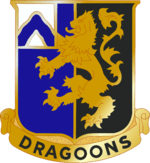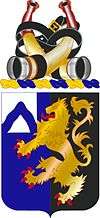48th Infantry Regiment (United States)
| 48th Infantry Regiment | |
|---|---|
|
Coat of Arms | |
| Active | 1917-89 |
| Country |
|
| Branch |
|
| Type | Infantry |
| Size | Regiment |
| Garrison/HQ | Ft Leonardwood, MO |
| Nickname(s) | "Blood and Guts!" |
| Motto(s) | "Dragoons" |
| Insignia | |
| Distinctive unit insignia |
 |
| U.S. Infantry Regiments | |
|---|---|
| Previous | Next |
| 47th Infantry Regiment | 49th Infantry Regiment |
The 48th Infantry Regiment is an infantry regiment in the United States Army first formed in 1917.
History
The 1st and 2nd Battalions, 48th Infantry, were mechanized infantry units assigned to the 3rd Armored Division (United States) (3AD) in West Germany during the Cold War. The battalions had overlapping assignments in the 3AD within the time frame 1957 to 1983 (joining the 2d of the 48th, the 1st of the 48th relocated to the 3AD at Gelnhausen in 1963 as part of the ROAD reorganization, from a prior assignment to 7th Army at Worms, Germany. In the 1963 ROAD reorganization 3d Armored Division's Combat Command B at Gelnhausen was redesignated as the Second Brigade). 2lt Colin Powell served in 2nd Bn 48th at Gelnhausen c1959. James S. Voss served as platoon leader, intelligence officer, and C company commander from 1975 to 1978. Following the 1963 ROAD reorganization, and along with the 1st Battalion, 33rd Armor Regiment (United States) which had been at Gelnhausen since the Spring of 1956, they comprised (1963 to 1983) the maneuver elements of the Division's 2d Brigade, stationed at Coleman Kaserne, in the city of Gelnhausen, Federal Republic of Germany. The Battalions served as part of NATO forces guarding the Inner-German Border against the Warsaw Pact. The unit crest of the 48th Infantry designated the unit as Dragoons. They are descended from National Guard units which trained for the First World War, and armored infantry battalions which served with the U.S. 7th Armored Division during World War II. The 48th Armored Infantry Battalion, along with 1st Battalion, 40th Armor, in particular fought a tough battle in Vielsalm, Belgium, holding off the German V Panzer Corps for three days at the crossing of the Salm river, during the German Ardennes Offensive (also known as Battle of the Bulge).
The 2d Battalion, 48th Infantry was inactivated at Gelnhausen on 15 October 1983 (and approximately two years later the 3d Bn, 33d Armor from 3d Armored Division's 1st Brigade at Kirch Goens was transferred to Gelnhausen and took up some of the vacated space). On 16 June 1989 the 1st Battalion, 48th Infantry was inactivated at Gelnhausen and its personnel were re-designated and continued there as 4th Battalion, 18th Infantry Regiment.
On June 16, 2017, the 48th Infantry's 2nd Battalion was reactivated in a ceremony at Fort Leonard Wood, Missouri to train BCT and comprised solely of United States Army Reserves Drill Sergeants.
Lineage
Constituted 15 May 1917 in the Regular Army as the 48th Infantry
Organized 1 June 1917 at Syracuse, New York
Assigned 31 July 1918 to the 20th Infantry Division (United States)
Relieved 28 February 1919 from assignment to the 20th Division
Inactivated 14 October 1921 at Camp Travis, Texas
Demobilized 31 July 1922
Reconstituted 27 February 1942 in the Regular Army as the 48th Armored Infantry and assigned to the 7th Armored Division (United States)
Activated 2 March 1942 at Camp Polk, Louisiana
Regiment broken up 20 September 1943 and its elements reorganized and redesignated as elements of the 7th Armored Division as follows:
- 48th Armored Infantry (less 1st and 2d Battalions) as the 48th Armored Infantry Battalion
- 1st Battalion as the 38th Armored Infantry Battalion
- 2d Battalion as the 23d Armored Infantry Battalion
After 20 September 1943 the above units underwent changes as follows:
- 48th Armored Infantry Battalion inactivated 8 October 1945 at Camp Myles Standish, Massachusetts
- Activated 24 November 1950 at Camp Roberts, California
- Inactivated 15 November 1953 at Camp Roberts, California
- 38th Armored Infantry Battalion inactivated 11 October 1945 at Camp Shanks, New York
- Activated 24 November 1950 at Camp Roberts, California
- Inactivated 15 November 1953 at Camp Roberts, California
- 23d Armored Infantry Battalion inactivated 11 October 1945 at Camp Kilmer, New Jersey
- Activated 24 November 1950 at Camp Roberts, California
- Inactivated 15 November 1953 at Camp Roberts, California
48th, 38th, and 23d Armored Infantry Battalions relieved 15 February 1957 from assignment to the 7th Armored Division and consolidated to form the 48th Infantry, a parent regiment under the Combat Arms Regimental System
Withdrawn 16 June 1989 from the Combat Arms Regimental System, reorganized under the United States Army Regimental System, and transferred to the United States Army Training and Doctrine Command
Distinctive unit insignia
- Description
A Gold color metal and enamel device 1 1⁄8 inches (2.9 cm) in height consisting of a shield blazoned: Per pale Azure and Sable a lion rampant Or, on a canton Argent a chevron wavy of the first. Attached below the shield a Gold scroll inscribed "DRAGOONS" in Black letters.
- Symbolism
The colors blue and white are used for Infantry. Black and gold are the colors of the Belgian coat of arms from which the Belgian lion is adapted. The wavy chevron on the canton is for descent from the 9th Infantry. The Belgian lion represents the organization’s action at Ardennes and St. Vith, for which it was awarded two unit decorations by the Belgian government.
- Background
The distinctive unit insignia was approved on 14 October 1958.
Coat of arms
- Blazon
- Shield- Per pale Azure and Sable a lion rampant Or, on a canton Argent a chevron wavy of the first.
- Crest- On a wreath Or and Azure two hunting horns in saltire Or, inserts Argent, mouthpieces Gules and straps interlaced Sable buckled of the first. Motto: DRAGOONS.
- Symbolism
- Shield- The colors blue and white are used for Infantry. Black and gold are the colors of the Belgian coat of arms from which the Belgian lion is adapted. The wavy chevron on the canton is for descent from the 9th Infantry. The Belgian lion represents the organization’s action at Ardennes and St. Vith, for which it was awarded two unit decorations by the Belgian government.
- Crest- The crest, consisting of Teutonic hunting horns, alludes to the German battle honors of World War II.
- Background- The coat of arms was originally approved for the 48th Infantry Regiment on 3 February 1921. It was redesignated for the 48th Armored Infantry Regiment on 19 May 1942. The insignia was redesignated for the 48th Armored Infantry Battalion on 30 November 1943. It was redesignated for the 48th Infantry Regiment and amended by the addition of a charge to and modification of the shield and a crest on 14 October 1958.
Campaign credit
- World War II
- Northern France
- Rhineland
- Ardennes-Alsace
- Central Europe
Decorations
- Presidential Unit Citation (Army) for ST. VITH
- Belgian Fourragere 1940
- Cited in the Order of the Day of the Belgian Army for action in the ARDENNES
- Cited in the Order of the Day of the Belgian Army for action at ST. VITH
See also
- U.S. Army Regimental System
- Coats of arms of U.S. Infantry Regiments
References
-
 This article incorporates public domain material from the United States Army Center of Military History website http://www.history.army.mil/html/forcestruc/lineages/branches/inf/0048in.htm.
This article incorporates public domain material from the United States Army Center of Military History website http://www.history.army.mil/html/forcestruc/lineages/branches/inf/0048in.htm. - http://www.3ad.org/48in/coat_of_arms.htm
